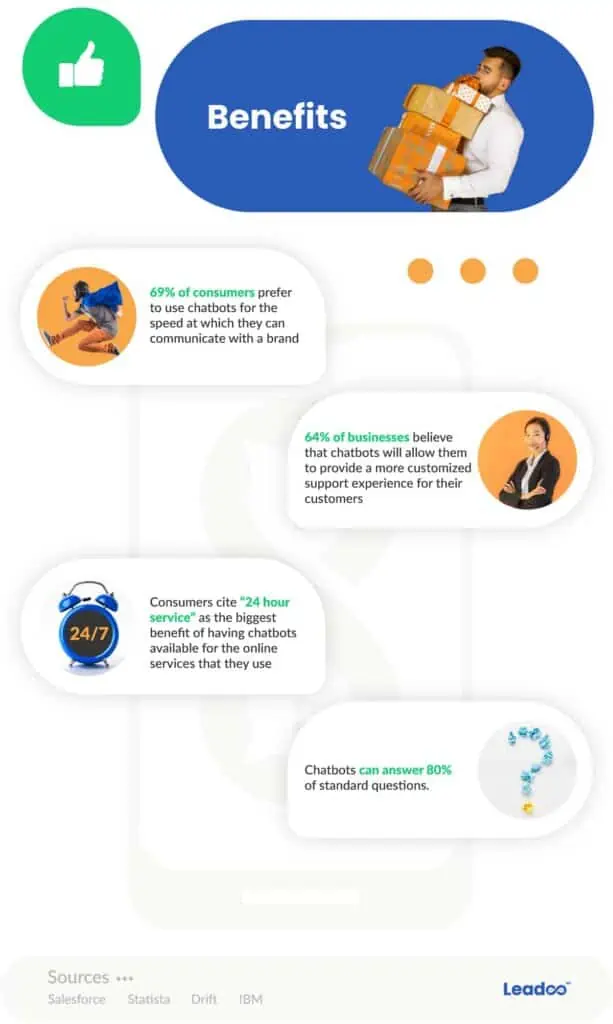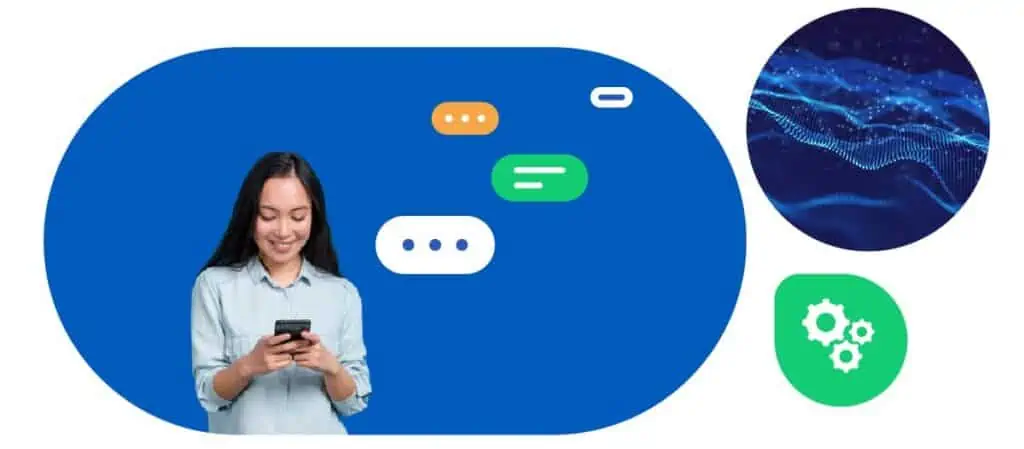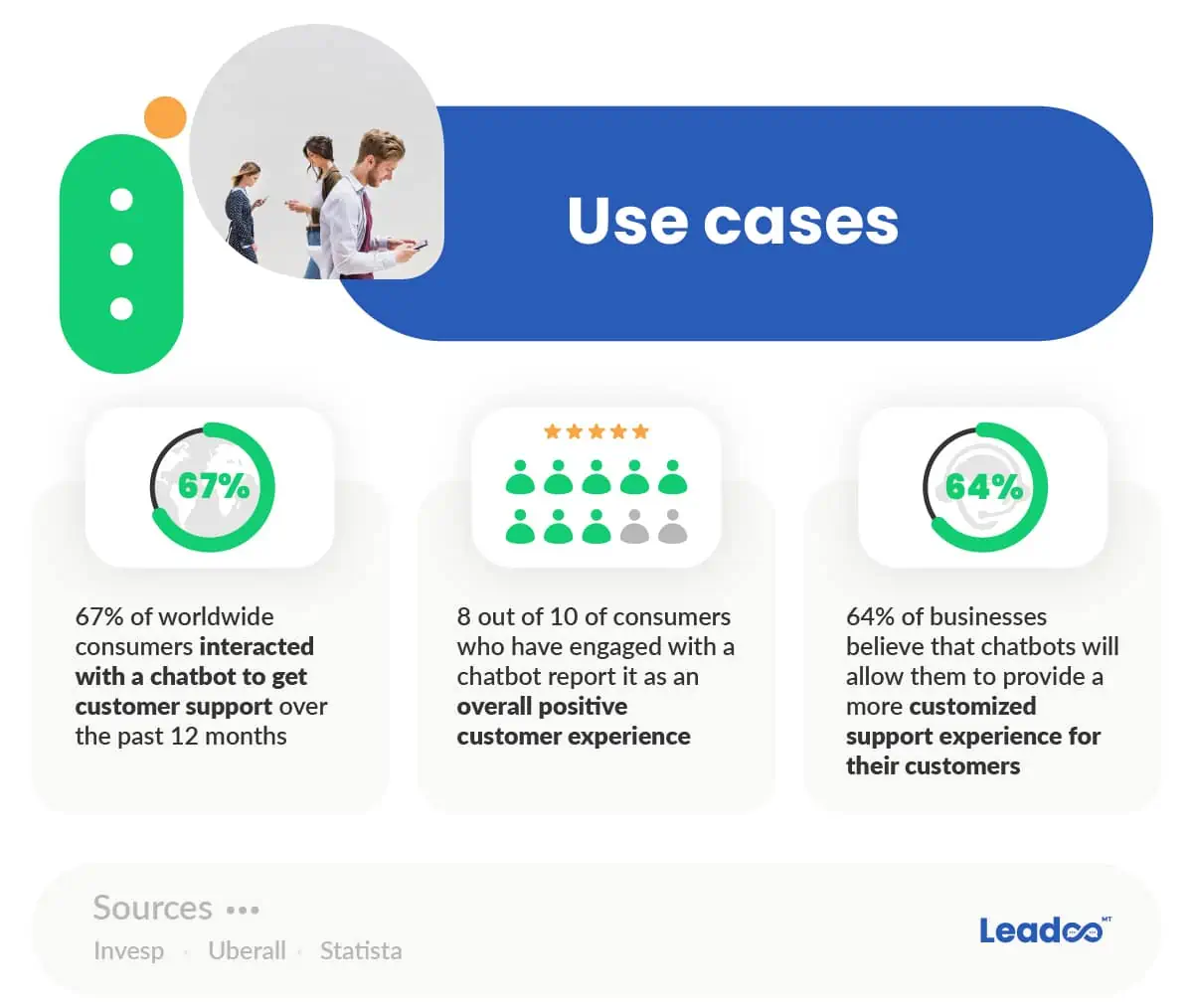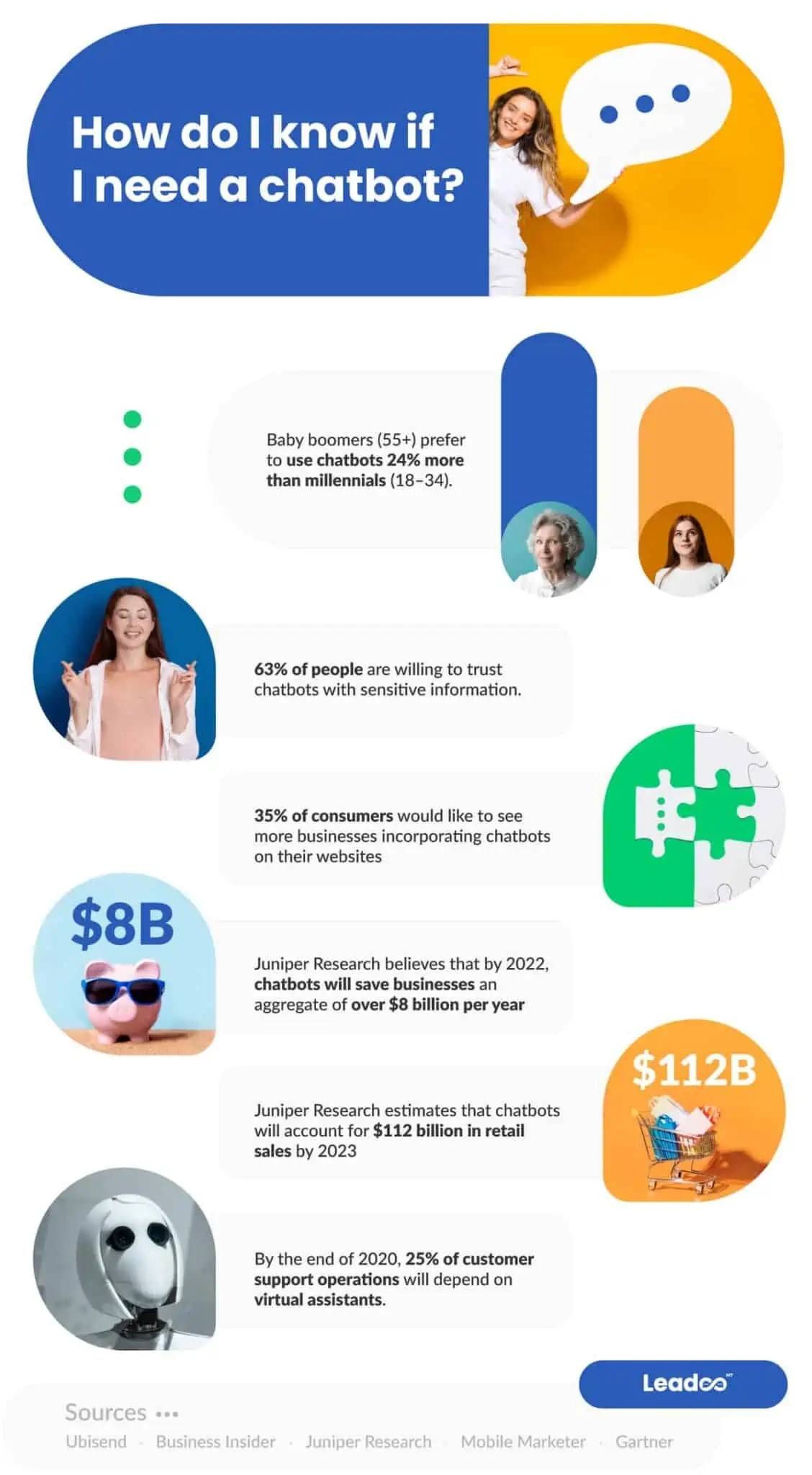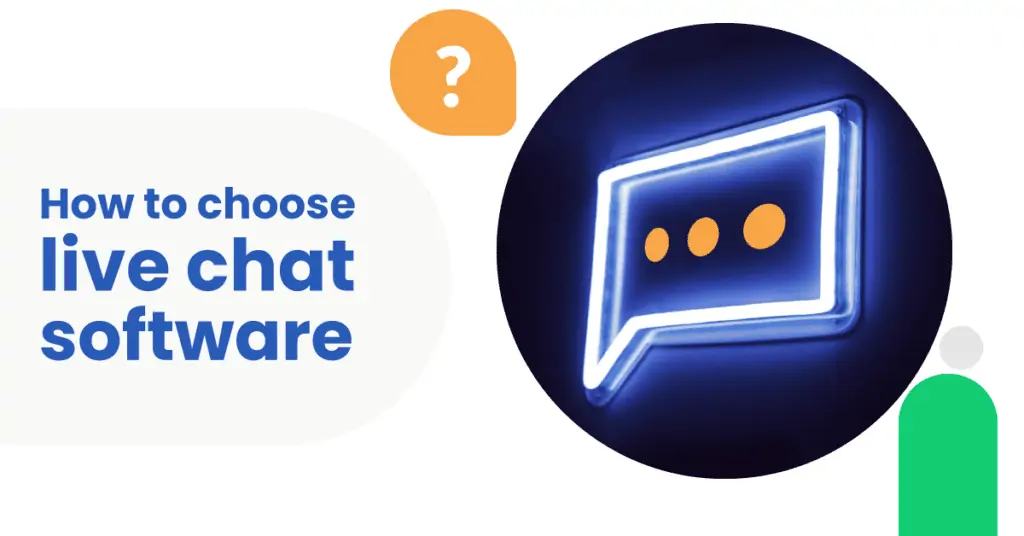What is a chatbot? When and why should you use chatbots?
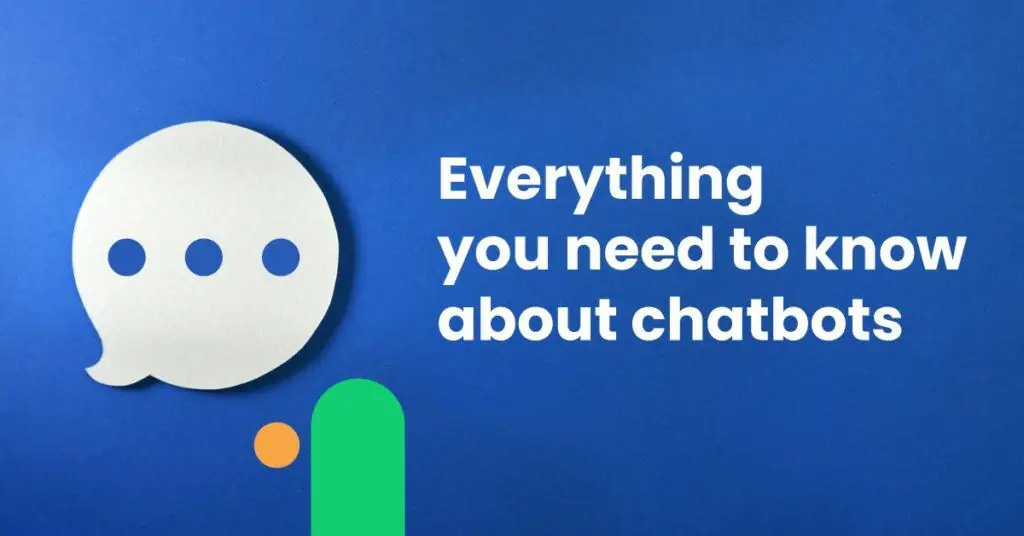
Table of Contents
What is a Chatbot?
Lets start by defining what is a chatbot. A chatbot, or a “bot”, is a software application used to conduct an online conversation. Chatbots are designed to simulate human conversations but on scale by automating different conversation paths.
The purpose of a chatbot is most often to provide personal service and help for website visitors. But they are as effective when used in sales, lead generation and also in the recruitment process. The use cases for chatbots are basically unlimited.
Some people might be intimidated by bots and machine conversations taking over. Most likely, though, you’re not one of these people as you’re already here. What might come as a surprise is that website visitors often don’t care whether it’s a machine or a person, as long as they get help quickly. And actually chatbots are in many ways just as humane as people.
This article offers a deep dive in the world of chatbots and consists of the following topics:
- The Benefits of Chatbots
- How Do Chatbots Work? And the Differences Between AI, ML and Rule-Based Chatbots
- Chatbot Use Cases
- How Do I Know If I Need a Chatbot?
- How to Choose the Right Chatbot For Our Business?
We’ve dropped bits and pieces of interesting chatbot data and facts here and there. So, all in all, you’ll find this article bursting with facts about bots.
The Benefits of Chatbots
In short: chatbots provide better customer experience to website visitors. Chatbots are good at this by making visitors feel they are heard and by being there 24/7/365.
The value of bots is often underappreciated because they are seen primarily in terms of customer service. Whilst this is still true, benefits such as personalization, engagement, visitor activation, and lead generation are just some of the modern ways chatbots add value to your customer relationship. Below we go into more detail with 8 essential values of chatbots:
Fast Response
In today’s marketplace, speed and convenience beat price more often as the most valued asset. Sinch found 68% of customers with a positive experience of chatbots, said they liked them because they answered questions more quickly. If you’re not able to offer customers a response on Live Chat within the first minute, then you need to think about bots.
Increase Sales
Well-designed chatbots can not only provide great customer support, they can use the information about the visitor’s interests and preferences and provide advice, offers and purchase suggestions. The traditional way to convert people from a website has been through a contact form. But there are several reasons why and how chatbots outperform them by a mile.
Reduce Costs
Chatbots have long been a great way to reduce costs. They can automate basic questions and conversations that suck up the time of your people. Even if you have Live Chat agents, bots respond more quickly. This is especially true when the dialogue is directed by the business.
Scale Staffing Resources
Much of the customer service experience and buying journey needs to follow a simple question and answer interaction. Sales reps want to be engaging in the most critical and valuable points on the journey, as do your support teams. Free up their time and see the energy and effectiveness of your staff improve as they eliminate repetitive work.
Enhance Customer Experience
As well as being fast, chatbots offer many other attributes that enhance CX, from anonymity and accuracy to multitasking and unwanted phone conversations. We all know what effect retention and decreasing churn have on the bottom line.
24/7 Service
Customers are increasingly enjoying positive experiences with chatbots, with many citing the speed and ease of access as the key benefit. Bots are based on predefined answers, so they can choose the question. Also, humans need to sleep but chatbots are there, 24/7.
Customer Activation
Highly engaged customers buy 90% more frequently and spend 60% more per purchase, with 3x the annual value. Activation is another way to look at engagement because often visitors, particularly those fresh, inbound leads first visiting your site need to be pointed in the right direction.
Customer Relationship
Personalization is a major factor in modern marketing and customers expect a relationship with their brands. Companies need to mirror more and more closely what consumers would receive from an in-person exchange. Conversational data can be analyzed and deliver invaluable insight into individualized marketing campaigns.
There is this one really thorough article we wrote about the benefits of bots for a better online customer experience that you might want to read. But now, let’s continue forward!
Featured material
Increasing Website Conversions with Chatbots
Find out how much chatbots can improve website conversion rates in your industry. Incl. data for 25 categories + pro tips for getting started.
Leadoo Report
Chatbot conversion data from 400 companies
How Do Chatbots Work?
There are several different ways to operate bots. The world is buzzing about artificial intelligence (AI) and machine learning (ML) chatbots. The truth is that most chatbots are rule-based and they do their job even better than the fancy high-tech bots. In all honesty, who hasn’t run into an AI chatbot that gets stuck when it doesn’t understand what you’re trying to ask of it…? No matter what kind of chatbot you go for, building a solid conversation flow is the key.
Like always, every different kind of chatbot has their pros and cons.
Rule-Based & Handcrafted Conversational Chatbots
In essence, this means that the conversation paths are defined and built into the bot. The underlying tech may be simpler (no machine learning or artificial intelligence involved) but this approach emphasizes the need to understand your target audience. In fact, understanding the needs and behaviors of your users and customers is essential whatever bot technology you employ…
USER EXPERIENCE: Users of handcrafted conversational bots are limited by a defined set of alternatives. The big difference is they won’t hit a wall on the way to conversion because the dialogue is based on a decision tree that always works. With handcrafted bots, if you know your target audience, a few chosen options are all you will ever need. Often, a set of defined options can actually be preferred because typing (especially on mobile) can be cumbersome. Plus, the conversation always flows towards a goal defined by you.
SETTING IT UP & OPTIMISING: Rule-based bots are quick to setup. It takes just a few hours to get started and you don’t need developers to help you get up and running. It’s also easy to adjust a handcrafted conversation compared to an algorithm. No need to re-think or re-teach an algorithm. Easy customizability means that you will actually make the adjustments when there’s a need for it. In the best-case scenario, your provider will even suggest improvements and take care of them for you.
AI & ML Chatbots
Essentially, AI or ML chatbots provide chatbot conversations by using sets of data. As the available data expands, they should become better as they gather and learn from the information.
USER EXPERIENCE: Most of the AI and ML chatbots are designed to handle a single task. This is due to the required processing power, storage and use of data and the like being quite expensive and not yet very sophisticated. If the user is set to complete a really niche task, the chatbot user experience is remarkably good. However, if the issue concerns a more complex task then the chatbot runs into trouble. For example, users in the process of purchase, seeking to confirm a delivery-related detail, might find the chatbot fails if it’s designed for customer service rather than sales.
SETTING IT UP & OPTIMISING: The setting up of AI & ML chatbots takes months or even years. It requires a vast amount of data and tech-savvy people in addition to customer support, marketing and/or salespeople to train the chatbots. The project team needs to invest a lot of time into the project. Even though you might think that AI and ML chatbots would optimise themselves, that’s seldom the case. AI chatbots require constant effort from the project team to improve.
Chatbot Use Cases
As mentioned earlier, a lot of companies are using chatbots for customer support whereas only a few are using them for generating more leads or online sales. In addition to those two use cases, chatbots can be used for recruitment, in the fight against a certain deadly virus, and many others. In truth, you are only limited by your own imagination.
Whatever use case you might want to pursue, there are best practices for how to build the perfect chatbot.
Here are some of the most common chatbot use cases:
Customer support
Well, this is by far the most common way of using chatbots. Automating the frontline of customer support allows the customer support functions of a company to focus on the most difficult issues. Bots can take care of the repetitive tasks that would normally overwhelm the support desk.
Generating leads
Live chat has been a source of leads for many websites for several years already. In light of this, it’s strange that it’s not common practice to use chatbots for the same purpose.
Chatbots can ask a visitor the same questions a sales rep would (within limits of course – you don’t want to annoy visitors). In addition, chatbots won’t need lunch breaks or have an ‘off day’. Finally, while many customers visit websites during the weekday, often evenings and weekends are the most lucrative.
Utilising chatbots for improving website conversion is a new tool to help you to reach your lead generation targets.
Increasing online sales
Often, we all require some reassurance about an issue before clicking that final “order” button in a webshop. Clicking on live chat in the bottom corner is one solution but it often takes a while for an agent to show up or the live chat is closed and there’s no one online.
With chatbots, it’s very easy to automate these “FAQ conversations” so that people get the help they need and get it quickly (it’s amazing how impatient many of us can be online!).
If you’re interested in chatbots as a way to improve your online sales and lead generation, then read this piece about 5 ways to increase online sales from your existing website traffic.
Recruitment
Using chatbots in recruitment is not yet very common but is about to disrupt the industry. As a sector, recruitment has been focused on internal processes rather putting the candidate first. However, this approach is changing fast as companies engage in a constant race for talent.
Chatbots in recruitment can lower the barrier for people to apply whilst also offering pre-screening on behalf of the recruiter. Chatbots are brilliant at dealing with the first phase of the recruitment process. Automated job interviews save hours of wasted time in screening and tailoring CV’s. Avoid the worst case scenario where all that unnecessary information is just copy-pasted into a company’s recruitment platform.
Utilizing chatbots as the first phase of the recruitment process also plays with our basic psychological need: the need to be recognized. That’s why a combination of chatbots and gamification offer the perfect hook to attract more and better talent to your open vacancies.
How Do I Know If I Need a Chatbot?
Chatbots are not necessarily for everyone and you need to ask yourself the right questions to determine if they will work for you. Below are some of the ways to examine the feasibility for yourself:
Engage & Activate
A whopping 97% of your website visitors are passive so only 3% are actively seeking a solution right then and there. This means that only a handful of people visiting your website will move mountains to get where they want to be. The majority will leave if you don’t activate and engage with them. Is your website activating visitors? Can they easily find what they are looking for? If you hesitate in answering either of these two question, you might want add chatbots or some other activating elements to your site.
Repetitive Questions
Ask yourself, how much time is spent by your teams answering common questions or redirecting people to different departments? What about trying to locate information on your website? Time spent with these repetitive queries is time away from more complex issues that truly need a human touch.
Poor CX
The question you need to ask yourself here is, how fast is fast enough? 82% of consumers expect an immediate response when they have a sales or marketing question. Our world is a demanding and instantaneous one, so if your team isn’t able to respond to customers fast, it’s time for a chatbot.
Maintain Privacy
When thinking about chatbots, consider customer data issues and how the information is shared and stored within your customer support systems. Some industries need to handle sensitive information. It’s important to consider security in your chatbot decision, but these privacy concerns shouldn’t hold you back. You’ll see below that Banking and Health sectors, for example, are major beneficiaries of chatbots.
Lead Qualification
Chatbots are great at qualifying leads. Two signs chatbots are right for you. First, that you have yet to define a clear lead qualification process. Second, that your sales team is overwhelmed by the number of potential leads coming in. In the first case, you should factor chatbots into your planning. In the second case, get a chatbot – like, yesterday!
Multi-channel Messaging
The last question to consider is, are you interacting with customers and leads in the medium they most prefer? We’re all using social media like Facebook and WhatsApp on a daily basis and some chatbot providers now offer integrations. This enables your team to manage all customer and visitor communication in one place.
If you need to think more about this, head to this article 5 signs you need a chatbot on your website. Definitely a valuable read.
How to Choose The Right Chatbot For Our Business?
There are few main things that can help you identify what kind of chatbot to choose for your company.
Time Available
How much time do you and others in your organisation have for setting up the chatbots? Can you you be there to constantly optimise, teach and maintain the chatbots? Do you want the value of chatbots but with a no-fuss, quick setup?
AI and ML chatbots are time-consuming projects but it doesn’t stop there. Someone needs to constantly train an AI bot as well as monitor the algorithm. Essentially, it’s not a project or tool, it’s an entirely new process for your company to manage.
Rule-based chatbots, on the other-hand, are quick and easy to set up and some providers even create and optimise bot conversations for you. Good customer support will pick your brain about your industry, customer behaviour and your company’s strengths and then create the bots for you.
Skills
What kind of skills do you possess in-house? Do you have skilled data and IT professionals committed to the project?
To get them up and running, all chatbots need the customer knowledge from your people (including sales, marketing and customer service). There’s no way around that. Then it comes down to what other competences you have in your organisation, like data and IT specialists. Have you got these kind of people in-house and how committed will they be? If you’re even a little unsure, taking AI or ML chatbots will probably lead to bad bots that don’t help anyone. If you only have business people involved, rule-based bots are definitely the way to go. Rule-based bots are quite easy to setup – check out our best practices here.
Setup Time
This is quick & easy to assess: do you need chatbots up and running asap? If your answer is yes, then go with rule-based chatbots. If not then you can allow other considerations to influence your chatbot decision.
Budget
Are you willing to invest hundreds of thousands into your chatbots or are you more interested in getting started with something smaller? Does the investment need to be precisely budgeted or do you have space to move if you need to invest more into your project?
Rule-based chatbots are fairly cheap and easy to budget. It is also quite easy to calculate the ROI for your investment.
The cost of AI and ML chatbot projects tend to start in the tens of thousands or even hundreds of thousands. Like many other IT projects, it’s hard to estimate the expense accurately beforehand.
Versatility
You are most likely planning chatbots for a specific use case, like automating website customer service or for lead generation purposes. Bear in mind that chatbots have several other use cases as it states in this article. Don’t let the chatbot technology you choose limit your options in the future.
Optimization & Analytics
One might think it’s easy to create conversations that help website visitors. Actually, that’s not always the case. That’s why it’s really important to have proper analytics in place when operating your chatbot. Analytics will show you which parts of the conversation work and which don’t.
AI, ML or Rule-Based chatbot?
All have technological pros and cons. For example, in all their intelligence, AI-bots still tend to have a low tolerance for real human language. Another weakness is that if people are given the opportunity to ask the bot anything then they really will. As a result, the conversation isn’t always moving towards conversion. On the other hand, handcrafted conversational bots don’t reach the adaptability level of AI. Nor do they have the ability to learn like ML bots do.
Much of the decision-making comes down to the service part of the deal. Having a dedicated expert guiding you through the design process, challenging your assumptions and providing further optimisations, can make all the difference in ensuring a return on your investment. In most cases, AI chatbots are unnecessary, particularly for smaller and (most) medium-sized businesses. Larger companies needing to organise customer service for thousands or millions of consumers are a better fit for AI and ML.
If your goal is to generate leads from your website, you should already know the questions and concerns that your prospects are seeking answers to. The same goes for handling frequently asked questions. In other words, nothing is stopping you from designing conversation paths that address your website visitors’ needs perfectly well. Handcrafted conversations are surprisingly effective. On top of that, they’re quick to get started with and easy to improve as you go.
If you are interested to dig deeper into the differences between AI, ML and Rule-Based chatbots, we wrote this thorough article on the subject.
Chatbot providers to look at:
Leadoo – A chatbot provider that offers chatbots along with messaging features and tools for the mapping of a customer journey. Focuses on making websites convert more sales and leads and enhance the customer experience. (Note: author of this article.)
Drift – A conversational marketing chatbot provider focusing on creating a better user experience through chatbots.
Intercom – A customer service-oriented chatbot provider that originates from live chats.
There is also this pretty handy comparison whitepaper that places these competitors up against one another and lets you decide which is the best.
Closing Words
Hopefully it is apparent to you that there are several benefits and use cases chatbots cater for. Chatbots can not only help you save money and time but also generating additional revenue by increasing online sales or lead generation.
This article contains the basics of bots whilst also offering some additional detail to help you deepen your understanding on the subject.
We hope you found this article useful. We would be especially grateful if you have time for some feedback by talking with our chatbot (obviously) below 😉 ⤵️
